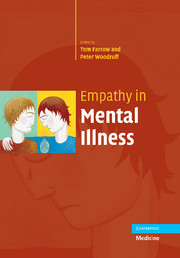Book contents
- Frontmatter
- Contents
- Foreword
- List of contributors
- Part I ‘Dysempathy’ in psychiatric samples
- Part II Empathy and related concepts in health
- Part III Empathy models, regulation and measurement of empathy
- 21 Balancing the empathy expense account: strategies for regulating empathic response
- 22 Empathic accuracy: measurement and potential clinical applications
- 23 A perception-action model for empathy
- 24 The Shared Manifold Hypothesis: embodied simulation and its role in empathy and social cognition
- 25 Using literature and the arts to develop empathy in medical students
- Index
23 - A perception-action model for empathy
from Part III - Empathy models, regulation and measurement of empathy
Published online by Cambridge University Press: 17 August 2009
- Frontmatter
- Contents
- Foreword
- List of contributors
- Part I ‘Dysempathy’ in psychiatric samples
- Part II Empathy and related concepts in health
- Part III Empathy models, regulation and measurement of empathy
- 21 Balancing the empathy expense account: strategies for regulating empathic response
- 22 Empathic accuracy: measurement and potential clinical applications
- 23 A perception-action model for empathy
- 24 The Shared Manifold Hypothesis: embodied simulation and its role in empathy and social cognition
- 25 Using literature and the arts to develop empathy in medical students
- Index
Summary
You can only understand people if you feel them in yourself
John Steinbeck (1952/2002), East of Eden, p. 444Introduction
This chapter describes and augments the perception-action model (PAM) of empathy, first detailed in Preston and de Waal (2002b). Empathy, ironically, is a term that means different things to different people. It has been difficult to distinguish empathy from sympathy because they both involve the emotional state of one related to the state of another. This problem was compounded by the fact that the mapping of the terms has recently reversed: what is now commonly called empathy was referred to before the middle of the twentieth century as sympathy (see Wispé, 1986 for a full discussion) and some researchers still use the old connotations (e.g. Batson, 1997).
According to a PAM, empathy is defined as a shared emotional experience occurring when one person (the subject) comes to feel a similar emotion to another (the object) as a result of perceiving the other's state. This process results from the fact that the subject's representations of the emotional state are automatically activated when the subject pays attention to the emotional state of the object. The neural mechanism assumes that brain areas have processing domains based on their cellular composition and connectivity; as such, there is no ‘empathy area’ and brain areas are recruited when the relevant domain is required by the task.
- Type
- Chapter
- Information
- Empathy in Mental Illness , pp. 428 - 447Publisher: Cambridge University PressPrint publication year: 2007
- 72
- Cited by

